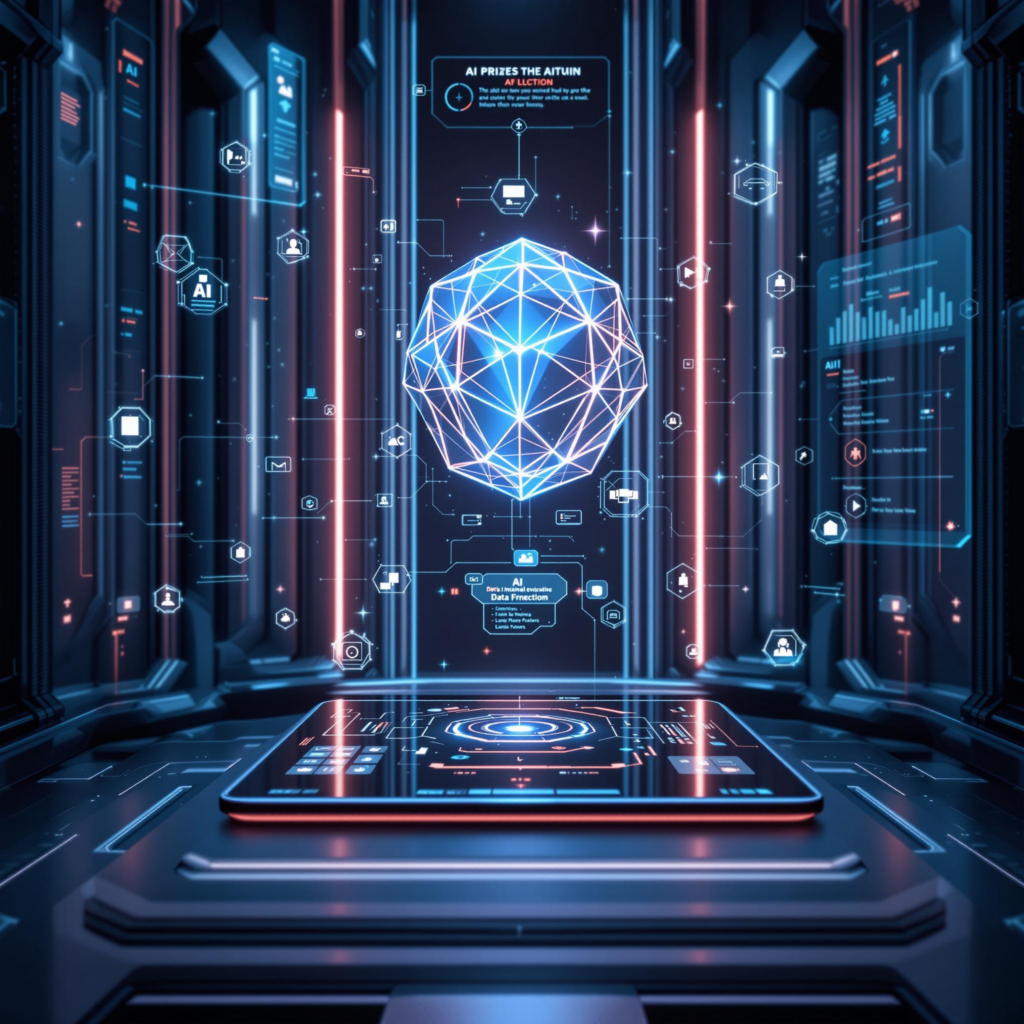Web design has evolved significantly over the past few decades, transitioning from static HTML pages to dynamic, responsive, and interactive platforms. Yet, none of these changes have been as transformative as the advent of Artificial Intelligence (AI). Once a futuristic concept, AI is now a vital component in shaping the way websites are conceived, designed, and interacted with. It’s not just enhancing aesthetic appeal; it’s revolutionizing the very fabric of user interaction, content delivery, and personalized experiences.
In today’s digital-first world, web design powered by AI is ushering in a new era—one that marries innovation with user-centric functionality. From automating mundane design tasks to crafting personalized web journeys, AI is now the silent partner in virtually every modern web development process. This shift is not just a trend; it’s a paradigm shift that will define the future of digital presence.
How AI Is Reshaping the Web Design Landscape
The traditional approach to web design involved extensive manual input—planning layouts, designing elements, coding functionalities, and testing across platforms. AI drastically shortens this cycle. Advanced algorithms can now analyze user data, predict behaviors, and make real-time adjustments to ensure optimal engagement and conversion.
Automation of Design Tasks
Tools like Adobe Sensei and Wix ADI (Artificial Design Intelligence) utilize machine learning to automate aspects of web design. These platforms can suggest layouts, recommend color schemes, and even generate copy based on the website’s purpose. Designers are no longer burdened with repetitive tasks, enabling them to focus on creativity and strategic user experience.
Dynamic Layouts and Responsive Adaptability
Responsive design is now expected, but AI takes this further by introducing dynamic layouts that adapt not just to screen size, but also to user preferences and behaviors. AI can track user interactions to reconfigure content placement, highlight key CTAs, or even reorder navigation structures in real-time—enhancing usability across devices.
Personalization at Scale: Beyond One-Size-Fits-All
Arguably, one of AI’s most powerful contributions is its ability to personalize user experiences at an unprecedented scale. Websites are no longer static experiences but living platforms that respond to individual needs.
Behavioral Analytics and Predictive Content
AI analyzes vast amounts of user data—including clicks, scrolls, dwell time, and search patterns—to understand intent. This allows websites to present personalized content, such as recommended products, blog posts, or services, tailored specifically to the user’s interests. Amazon, Netflix, and Spotify exemplify this in the eCommerce and content space, but the same principles apply to nearly any site.
Real-Time Customization
Unlike traditional user segmentation, AI enables micro-segmentation—adapting the experience for each user individually in real-time. For instance, a returning visitor might see different homepage content compared to a new user. AI tracks previous interactions and predicts the next best action, creating a more intuitive and meaningful user journey.
AI-Powered Tools That Are Transforming Web Design
A growing ecosystem of AI tools is now available to assist designers and developers. These tools don’t just speed up workflows—they introduce smart automation, error detection, and enhancement suggestions.
- ChatGPT & Copy.ai: Used to generate on-brand web copy based on user prompts.
- Uizard & Figma AI: Help convert wireframes into high-fidelity prototypes quickly.
- Hotjar & CrazyEgg: Combine heatmap analytics with AI insights to improve UX.
- Framer AI: Automates entire site building from prompts, ideal for MVP launches.
These technologies reduce development time, improve accuracy, and often outperform human-driven A/B tests in determining optimal layouts and content placements.
Enhancing UX: AI and Human-Centered Design
User experience (UX) remains the cornerstone of successful web design, and AI significantly boosts its effectiveness by anticipating and addressing user needs with precision.
Intelligent Chatbots and Virtual Assistants
AI chatbots have moved beyond simple query responses. Today’s bots can guide users through complex purchasing decisions, resolve customer service issues, and even complete transactions. Integrated with NLP (Natural Language Processing), these bots understand context, sentiment, and nuance—providing a seamless interaction layer.
Accessibility Improvements
AI also plays a key role in improving website accessibility. Tools like Microsoft’s Seeing AI and Google’s Lookout help visually impaired users navigate web content. AI-driven image recognition automatically generates alt text, while voice-command functionalities enhance usability for individuals with physical limitations.
Load Time Optimization
Speed is essential for UX and SEO. AI optimizes content delivery based on device type, location, and usage patterns. CDN providers like Cloudflare and Akamai use AI to intelligently cache content and route traffic for faster load times, which directly contributes to reduced bounce rates and higher engagement.
SEO Optimization and Content Strategy
Search engine algorithms have become more sophisticated, and AI-powered web design aligns closely with these evolving requirements. AI doesn’t just enhance UX—it bolsters SEO performance across the board.
AI-Driven Content Creation
AI tools can generate SEO-friendly content that aligns with keyword trends, readability scores, and voice search optimization. Platforms like SurferSEO and Clearscope analyze top-performing content and provide actionable insights for ranking higher on Google.
Structured Data and Semantic Search
AI simplifies the implementation of structured data (schema markup), helping search engines understand page content more accurately. This improves visibility in rich snippets and voice search results. Semantic search, which relies on AI-driven context recognition, further reinforces the importance of well-structured, AI-enhanced content.
Real-Time Performance Tracking
Analytics tools powered by AI, such as Google Analytics 4 and IBM Watson, provide deeper insights into user journeys, conversion paths, and engagement metrics. This data helps continuously refine and iterate web design strategies, ensuring long-term SEO health.
Security and Maintenance with AI
AI is not just a tool for the front end—it plays a crucial role in web maintenance and cybersecurity.
Automated Security Protocols
AI systems can detect anomalies in traffic, flag suspicious behavior, and block potential threats before they cause harm. By analyzing patterns and anomalies, these systems offer real-time protection against SQL injections, DDoS attacks, and phishing attempts.
Predictive Maintenance
AI-powered systems monitor site health continuously, identifying performance bottlenecks, outdated plugins, or broken links. Predictive maintenance reduces downtime and prevents issues before they affect the user experience.
The Future of AI in Web Design
As AI technology matures, its influence on web design will become even more pronounced. Emerging trends suggest a future where AI not only supports but leads web development initiatives.
Autonomous Design Systems
We are moving toward platforms that require minimal human input. These systems can understand business goals, target audiences, and competitive landscapes to design and deploy websites autonomously. While still in their infancy, tools like Bookmark’s AIDA are pioneering this concept.
Integration with AR and VR
The combination of AI, augmented reality (AR), and virtual reality (VR) is opening doors to immersive web experiences. AI tailors AR/VR interfaces in real-time, enabling personalized virtual tours, 3D product showcases, and gamified user interfaces—especially in real estate, retail, and education.
Ethical AI and Transparent Design
With great power comes great responsibility. The future of AI in web design will also focus on ethical considerations—ensuring transparency, fairness, and user consent in data-driven personalization. Designers must balance automation with trust to maintain credibility and user loyalty.
Challenges and Considerations
Despite its benefits, AI integration comes with its own set of challenges. Not all solutions are plug-and-play, and designers must be cautious in choosing tools that align with brand goals and technical capabilities.
Data Privacy Concerns
Using AI for personalization means collecting and processing user data. Designers must ensure compliance with regulations like GDPR and CCPA to avoid legal pitfalls. Transparency in data use and robust encryption methods are essential.
Over-Reliance on Automation
While AI can generate impressive results, over-reliance on automation risks losing the human touch that makes websites relatable. Designers must strike a balance between AI efficiency and creative intuition.
Learning Curve
Adopting AI tools often involves a steep learning curve. Teams need to invest in training and experimentation to leverage these technologies effectively. This can be a barrier for smaller businesses or those with limited technical resources.
Embracing AI: A Strategic Imperative
Incorporating AI into web design is no longer optional—it’s essential for brands aiming to remain competitive. The benefits are tangible: higher conversion rates, improved user satisfaction, streamlined workflows, and better SEO performance.
Companies that embrace AI today are positioning themselves as digital pioneers. They’re not just optimizing their websites—they’re redefining their customer relationships. Conversely, brands that delay AI adoption risk falling behind in an increasingly intelligent digital landscape.
Conclusion: Web Design Reimagined
The evolution of web design through AI is not a mere technological shift; it is a reimagination of how digital experiences are crafted, delivered, and refined. Artificial intelligence has made it possible to design websites that are more intelligent, responsive, and empathetic to user needs.
As we look ahead, AI will continue to redefine the boundaries of what’s possible—ushering in an age of smart, self-improving, and deeply personalized websites. Businesses that recognize this transformation and act on it will not just thrive—they will lead.
Ready to Transform Your Website with AI?
The future of web design is here—don’t get left behind. Whether you’re launching a new site or revamping an existing one, now is the time to harness the power of AI. Let intelligent design elevate your digital presence, drive engagement, and deliver real results. Start your AI-powered web transformation today—connect with us to learn how.


One Response
A recent read on webanto.com highlighted how artificial intelligence is transforming the web design landscape, and it truly opened the eyes to what the future holds. The discussion on AI’s Role in Shaping the Future of Web Design provided a deep dive into the emerging trends that are redefining creativity and functionality for websites. The insights shared were impressively detailed, offering a balanced perspective on the blend of technology with design artistry.
During multiple projects, the incorporation of AI tools has not only streamlined workflows but also elevated designs beyond traditional boundaries. The article presented a nuanced view of how intelligent algorithms can predict user behavior, optimize layouts, and ultimately create more personalized web experiences. This practical integration of AI into design inspired many to experiment with innovative features, enhancing user engagement without compromising on visual appeal.
One standout aspect was the thoughtful explanation of technical details without resorting to jargon overload, making the content accessible to both seasoned professionals and curious beginners. The emphasis on quality and condition of modern design tools was refreshing, and it highlighted how meticulous craftsmanship in design is being complemented by smart automation. It’s clear that the future of web design is not only about aesthetics but also about intelligent functionality that adapts to user needs.
Over time, the evolution in the field has demonstrated that when creativity meets cutting-edge technology, the results can effectively transform the online space. The review offers both an honest critique and an enthusiastic endorsement of a future where design is infinitely more adaptive, interactive, and user-centric. For anyone interested in exploring the crossroads of technology and design, there’s plenty of value in diving deeper into the ideas presented.
Overall, this exploration was both informative and inspiring. It serves as a gentle recommendation for designers and digital enthusiasts alike to invest some time in understanding these advancements. The experience cultivated a greater appreciation for the next wave of design innovation that promises to shape not just the websites we interact with, but the digital experiences we cherish daily.